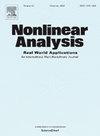平流环境中具有变搜索率的捕食者-猎物模型的稳定性和分岔
IF 1.8
3区 数学
Q1 MATHEMATICS, APPLIED
引用次数: 0
摘要
本文考虑了平流环境中具有可变搜索率的捕食者-猎物模型。首先,利用主特征值的变分表达式,分析了其关于参数的连续性和单调性,并结合先验估计和比较原理等技术,得到了平凡和半平凡稳态解的全局渐近稳定性。以平流速率q和反映搜索速率大小的半饱和常数g为参数,对系统的长时间动态行为进行了完全分类。此外,由于主特征值和主特征函数的性质,我们分别利用分岔理论和持续理论建立了正稳态的局部存在性和稳定性,以及全局存在性。此外,对于具有平流项和非线性泛函响应的非单调系统,我们证明了当捕食者具有中等搜索速率时,它在小平流速率下表现出唯一的空间非齐次正稳态。更有趣的是,我们观察到复杂的现象,包括空间非均匀周期解,并且发现当搜索速率较大时,猎物和捕食者都倾向于向河中部移动。本文章由计算机程序翻译,如有差异,请以英文原文为准。
Stability and bifurcation of a predator–prey model with variable search rate in advective environments
In this paper, we consider a predator–prey model with variable search rate in advective environments. First, by applying the variational expression of the principal eigenvalue, we analyze its continuity and monotonicity with respect to parameters, and combine techniques such as priori estimates and comparison principle to obtain the global asymptotic stability of trivial and semi-trivial steady-state solutions. The complete classification of long time dynamic behaviors of the system is conducted using advection rate and half-saturation constant which is used to reflect the magnitude of search rate as parameters. Moreover, owing to the properties of the principal eigenvalue and principal eigenfunction, we establish the local existence and stability of the positive steady state, as well as the global existence, through bifurcation theory and persistence theory, respectively. Furthermore, for such non-monotone system with advective term and nonlinear functional response, we prove that it exhibits a unique spatially inhomogeneous positive steady state for a small advection rate when the predator has an intermediate search rate. More interestingly, we observe complex phenomena, including spatially inhomogeneous periodic solution, and find that both prey and predator tend to move towards the middle of the river when the search rate is large.
求助全文
通过发布文献求助,成功后即可免费获取论文全文。
去求助
来源期刊
CiteScore
3.80
自引率
5.00%
发文量
176
审稿时长
59 days
期刊介绍:
Nonlinear Analysis: Real World Applications welcomes all research articles of the highest quality with special emphasis on applying techniques of nonlinear analysis to model and to treat nonlinear phenomena with which nature confronts us. Coverage of applications includes any branch of science and technology such as solid and fluid mechanics, material science, mathematical biology and chemistry, control theory, and inverse problems.
The aim of Nonlinear Analysis: Real World Applications is to publish articles which are predominantly devoted to employing methods and techniques from analysis, including partial differential equations, functional analysis, dynamical systems and evolution equations, calculus of variations, and bifurcations theory.

 求助内容:
求助内容: 应助结果提醒方式:
应助结果提醒方式:


